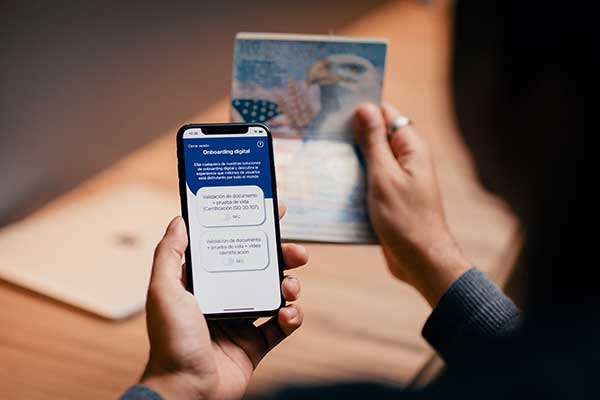Utilizing biometric capabilities daily in both online and offline scenarios.

By: Eduardo Azanza, CEO, Veridas
The physical process of human needs being met continues to become more accessible. What was once a hand-written check to buy weekly groceries is now a simple tap of our phones. Now, we see this transition beginning again as the steps to board a plane or access our mobile phones become immensely smoother. While most of us had to prove our identity with a pin or an array of documents, we can now do so with biometric technology. However, with mass technological advances comes understandable concerns.
As the physical and digital worlds converge, biometric technology presents a powerful personal authentication solution to prove our identities. It increases convenience in many areas, as it removes the burden of users remembering multiple passwords and pins. Biometric technology is also rapidly becoming the safer and more secure option, as industry leaders like Apple, which uses biometrics for Face ID, have stated that the chances of mistaken identity are less than one to one million.
Along with the convenience of authenticating for digital services such as online banking, biometrics has a growing impact on the physical world. For example, quicker verification processes such as face biometric are reducing airport queue times. It also serves to identify customers confidently for institutes like venues, corporate buildings, banks, or government work.
However, as biometric technology requires sensitive data to be gathered, stored, and transmitted, the general public has worries regarding privacy risks. Biometric technology works around a unique identity that remains unchanged, unlike codes and encryption keys that can be reset. Therefore, compromised biometric data used to access private information and steal someone’s identity is far more endangering than a phished password. The increased use of CCTV to track individuals using facial recognition has also heightened concerns about surveillance and security, particularly on the government level.
These are valid concerns, and the industry should rely more on vendors that are helping the users keep their identity data rather than storing it. This means that these vendors are focusing more on transparency and long-term success versus capital gain and recognition.
With the growing demand for safe and dependable identity verification, more and more clients are advancing toward the latest biometric technology. Voice biometrics has become widespread recently due to remote working, e-commerce, and online banking.
For companies looking at implementing voice biometrics as a part of their identity authentication process, it is crucial to ensure the reliability and security of the third-party verified technology. A reliable third-party verification technology is one that upholds government standards, providing businesses that their biometric authentication process is up to date with the latest fraud prevention methods and is dependable and safe.
They must also invest in voice anti-spoofing technology that examines audio to detect Presentation Attacks. These attacks occur when adversaries play pre-recorded audio through a speaker to imitate someone. This can help threat actors access sensitive information if it isn’t detected promptly.
Another way to bolster an identification process is by using multi-factor authentication. In this process, voice biometrics are combined with other forms of authentication, including document verification or facial recognition. Even if one factor is compromised, it will be useless if the attacker cannot acquire the other elements simultaneously.
So, to secure a scheme completely, there must be multiple layers of biometrics. By combining voice and facial printing, an organization can achieve a higher level of security as it makes it harder for adversaries to impersonate someone. Unlike traditional passwords or physical IDs, biometrics are unique to each person and are non-replicable. This makes it difficult for unauthorized access or identity fraud.
As biometrics become widespread, the field is becoming more tightly regulated worldwide.
Businesses collecting and storing biometric information will need to adhere to several regulations. For example, the General Data Protection Regulation (GDPR) specifies biometric data as ‘sensitive’ personal information concerning fundamental rights and freedoms. The GDPR states that this type of data requires strong protection, and hence it requires a legal basis and privacy impact assessment while processing.
In North America, California businesses must comply with the California Consumer Privacy Act (CCPA), governing the collection and usage of customer data, including special requirements for biometric data.
Furthermore, ISO/IEC 30107 provides a framework for detecting presentation attacks (PAD) on biometric data, which can be sourced directly, online, or from existing databases. Businesses need to watch for potential biometric spoofs, detectable via PAD. The US National Institute of Standards and Technology (NIST), the leading institution for biometric solutions, periodically evaluates biometric devices from various vendors, providing unbiased accuracy and performance ratings in diverse environments. Organizations are obligated to submit their technologies to NIST for assessment.
Biometric technology will continue to advance and become widespread due to its convenience and agility. Hence, businesses must be able to reliably protect data, identify deepfakes, and comply with regulations.

About the Author:
Eduardo Azanza is the CEO and co-founder of Veridas, a biometric technology company founded in 2012. With over 15 years of experience in the field, Azanza has been a driving force behind Veridas’ success in developing cutting-edge biometric solutions for identity verification, digital onboarding, and access control. Under his leadership, Veridas has become a leading provider of biometric technology, with its solutions trusted by financial institutions, governments, and businesses around the world.
Scott Ellyson, CEO of East West Manufacturing, brings decades of global manufacturing and supply chain leadership to the conversation. In this episode, he shares practical insights on scaling operations, navigating complexity, and building resilient manufacturing networks in an increasingly connected world.